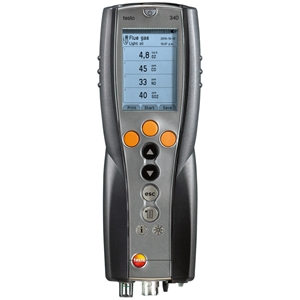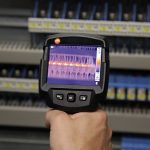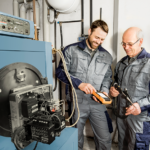Any industry that utilises internal combustion will find it absolutely critical to keep their systems within the optimum operational parameters.
Variation in flue gas can often lead to an engine losing its effectiveness, and ultimately, hamper productivity and general output.
The testo 340 flue gas analyser for industry can help alleviate any such problems, thanks to its ability to precisely measure emissions.
Key features
One of the main features of the testo 340 is its sheer ease of use. Twinning a compact design with reliable technology, the unit makes it incredibly easy to register and record accurate measurements.
With more than a glancing eye cast over versatility, it has the space to house up to four gas sensors. An oxygen sensor comes as standard, but there are carbon monoxide, nitrogen oxide, nitrogen dioxide and sulphur dioxide sensors available.
Furthermore, the testo 340 is also suitable for measuring low concentrations of carbon monoxide and nitrogen oxide with optional high accuracy sensors.
Thanks to the optional automatic measuring range extension, whichever sensor is housed in the testo 340 has its spectrum of readings extended by a factor of two. There’s also automatic sensor protection, meaning the unit will not allow itself to be overloaded, even under the added strain at high gas concentrations.
Single slot dilution to a factor of five is standard and can be used to also extend the measuring range of any of the following sensors:
- Carbon monoxide. 50,000 parts per million (ppm)
- Nitrogen oxide. 20,000 ppm
- Sulphur dioxide. 25,000 ppm
After gathering readings, deciphering the information to find the root cause of any issues is made easy when the unit is twinned with easyEmission software.
Readings are shown in either table or graph form, and can even be made available online through Bluetooth wireless transmission or USB connection. These can then be turned into physical insights and distributed accordingly when used alongside a testo Bluetooth printer.
The data can be implemented into individual formulas which can take into account any specific fuels, making it incredibly easy to pinpoint any inefficiencies.
Only adding to its versatility, there are also a number of probes available which can be used in tandem with the testo 340. Different flue gas probe lengths, diametres and temperature tolerances all add up to create a flexible solution which is applicable across many industries.
Low concentration gases
Accurately measuring gases with low concentrations can be critical to the efficiency of systems such as industrial turbines.
Furthermore, as the onus is on a variety of industries to do their best to limit environmental emissions, combustion systems that emit low concentrations of nitrogen oxide are becoming more important.
Low nitrogen oxide systems limit their gas output by allowing initial combustion to take place in a dense fuel-rich environment. Once the first part of the process takes place, further air is pumped into the combustion chamber to ensure maximum efficiency, while also reducing the concentration of nitrogen produced by the system.
Treating flue gas after the fact can be costly, so keeping nitrogen oxide concentration to a minimum – and tracking and measuring it accordingly – is crucial for industries which are attempting to complete their processes in a cleaner fashion.
To use a specific example of just how low the concentration of nitrogen oxide can be in some instances, specialist combustion technology company Alzeta offer metal-fibre burners that have a concentration as low as 7 ppm.
Low nitrogen oxide combustion has a plethora of applications. Any system that requires a boiler or furnace – including industries varying from power production to metal manufacturing – is capable of utilising a burner that outputs a low concentration of nitrogen oxide.
Accurate flue gas analysis is key to ensuring that the output from any combustion system is consistent. The versatility, robustness and scalability of the testo 340 is ideal for industry professionals looking to carry out measurement, monitoring and maintenance work in their particular sector.









 Reduce cooking oil costs while ensuring quality
Reduce cooking oil costs while ensuring quality Expert knowledge on CO2 monitoring
Expert knowledge on CO2 monitoring Refrigeration knowledge - in 3 modules
Refrigeration knowledge - in 3 modules



